ENTS,

Grand vista south with Ron in tree #2 |
On Tuesday
June 7th I and three others climbed some huge, old-growth
eastern
hemlocks in the Great Smoky Mountains National Park. The trees
ranged from
120 to over 150' tall. We were hired to collect foliar samples
to assess the
concentrations of imidacloprid in the needles. Imidacloprid is a
systemic
insecticide (manufactured by BAYER) widely and successfully used
in
combating the hemlock woolly adelgid. Ten trees were treated on
Jim Branch,
Cataloochee, in November 2002 with a soil application of 75% WSP
concentration at the maximum dosage on the label (1.6 oz per
24" diameter at
4.5 feet). We had previously climbed these trees in the spring
of 2003 to
collect foliar samples, and some imidacloprid was detected. This
return
climb was to assess the recovery of the trees (my goal as an
applicator) and
to see if the chemical is still in the tree and in what
concentrations (one
of the NPS goals). Very little is known about how to treat huge
hemlocks for
HWA infestations.

Brian and Jason in tree #6 (left) and #7 (right) respectively. |
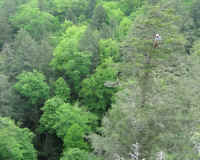
Brian perched over the abyss. |
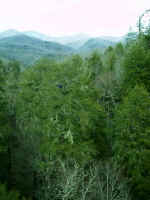
Chris in tree 5. |
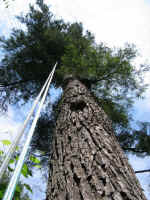
Descending tree #1. |
Overall, the climbers reported the trees to be essentially clean
of adelgid
with very little to no living insects found on the trees. What
was striking
was that some of the trees had a heavy crop of HWA this year but
they were
dead and no new brood (May-June) was detected after the first
maturing brood
following winter (March- April). Distorted new growth was
evident on the
more vigorous portions of the trees. Heavy HWA infestations
typically cause
a "droop" in the terminal leader of the branch, which
can lead to a
distorted twig after recovery (see photo).
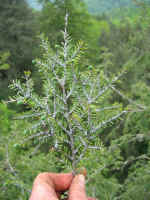
Dead adelgids from spring 2005- no second brood! |
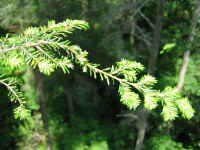
Distorted but healthy re-growth. |
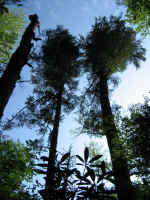
Healthy hemlocks. |
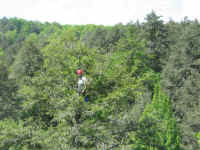
Ron in tree #2. |
All trees exhibited varying degrees of recovery with seemingly
random limbs
fully green and growing next to gray, declining limbs a few
inches away. The
apparent delay in chemical activity and the light to moderate
infestation at
the time of treatment may explain the patchy recovery.
Presumably, the
heavily infested limbs would be more impacted than the light to
non-infested
limbs. In general, the tops of the trees were much
better-looking and
vigorous than the lower limbs. However, some trees had
perfect-looking lower
limbs with mid-canopy limbs devoid of new growth. If no buds
survived the
previous infestations the limbs will die as the older needles
drop off.
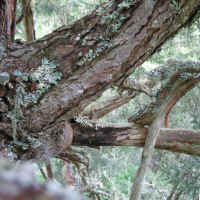
Tree #8 gnarl detail stitched. |
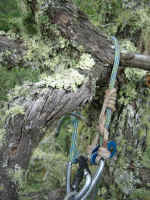
Lichen garden Tree #8 stitched.
|
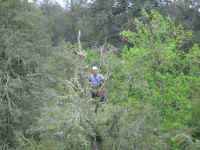
Will in top of Tree #8 @ 140'. |

Tree #6 and #7 stitch; Brian at base of #6. |
Tree
#9 seems destined to die, as it had almost no new growth and was
not easily
differentiated from the non-treated trees. Tree # 10 however,
was in
excellent shape and was green throughout the canopy. Typically,
untreated
trees surrounding the 10 treated trees were gray and declining
rapidly.
There were a few green trees visible here and there, suggesting
that a
predator beetle release may be having an impact.
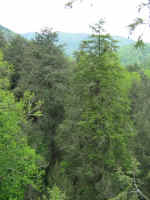
Tree #10 green and happy- imidacloprid works! |

Ron in tree #10 full view. |

Will and Ron in canopy; tree #8 (Will-left) tree # 10 (Ron-right), northwest view. |
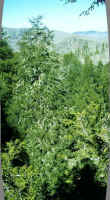
Tree 10 composite 2003. |
Just two years of HWA made a huge impact. Just look at the
photos taken in
2003 and compare them to 2005. In 2003, the trees were all
green. In 2005
the treated trees were easy to pick out as they were simply--
green.
Essentially no new growth was seen on neighboring trees, and
some trees were
already dead, but maybe not entirely due to HWA. In addition to
all limbs,
entire tops of neighboring hemlocks were infested with HWA for
lengths of 10
feet or more covering even the trunk to 3 inches in diameter.
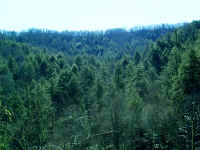
South vista 2003
|
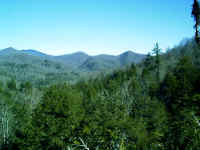
Jim Branch north vista 2003. |

Grand vista north |
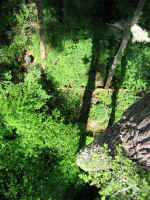
Will's shadow |

Gray ghost 2005. |
I have yet to hear the results of the study, but I know that
imidacloprid
works. I use it almost daily against HWA and have had excellent,
albeit
delayed results. Some trees I treated in 2001 are still free of
HWA with
only one soil treatment. It seems the Jim Branch trees may need
another
dose, but we will know for sure soon. Other studies indicate
that a very
small concentration of imidacloprid can prevent HWA
re-infestation. But
recovery seems slow on these huge trees.
Will Blozan
|